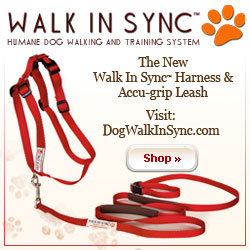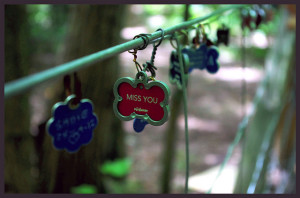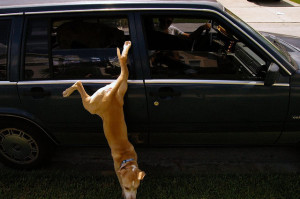You suddenly realize that your dog is missing. As you consider that you might never see your beloved pet again, panic, worry and guilt set in. After agonizing hours or days, your dog shows up, all is well again, and you promise yourself that this will never happen again. The sad truth is that it can happen again, and, in many cases, lost dogs are never found. This devastating experience can be averted by taking the right precautions.
Here are some tips to keep in mind to help prevent your dog from getting lost, as well as suggestions to make your dog’s return more likely.
Maintain fences and gates
Dogs often escape when there are gaps in fences or gates. A fence should be tall enough so that your dog cannot jump over it or sneak through it. It is best to have your dog’s play area in the back of your home and away from the street. A guest can open or close the gate making it easy for a dog to escape. In the front of your home, dogs could become distracted by the activity on the street (people passing by, cars, bicycles, skateboards…). Keep in mind that many dogs like to dig. You should frequently check the perimeter of the fence to make sure there are no possible escape routes.
A fence should be tall enough so that your dog cannot jump over it or sneak through it. It is best to have your dog’s play area in the back of your home and away from the street. A guest can open or close the gate making it easy for a dog to escape. In the front of your home, dogs could become distracted by the activity on the street (people passing by, cars, bicycles, skateboards…). Keep in mind that many dogs like to dig. You should frequently check the perimeter of the fence to make sure there are no possible escape routes.
Keep your dog on a leash & make sure that the collar/harness fits properly
 Keep your dog on a leash except when he is in an enclosed area like a dog run or a fenced-in yard. If your dog is secured on a leash and you are holding the leash firmly, he will not be able to go further than the extent of the leash. I wrap the leash around my hand twice to make it most secure.
Keep your dog on a leash except when he is in an enclosed area like a dog run or a fenced-in yard. If your dog is secured on a leash and you are holding the leash firmly, he will not be able to go further than the extent of the leash. I wrap the leash around my hand twice to make it most secure.
I can’t begin to tell you how often I see dogs with loose collars and loose harnesses. To check if the collar fits properly, once it is on the dog, make sure that when you place 2 fingers under the inside of the collar, they fit comfortably. You don’t want the dog to choke, but you also don’t want your dog to slip out of his collar. When dogs are walked with a leash connected to a collar it puts great stress on a dog’s trachea if he pulls. Using a collar just for keeping tags attached to is fine. There are really nice collars that can be ordered with your phone number embroidered or printed on them.
I use the Walk-In-Sync harness for my dogs. In fact, I wrote an article about it, The Best Harness Ever! so you may read about how unique is in detail.I included it in My Favorites page.
Teach your dog the most important command
Teaching your dog the “come” command is essential. C alling your dog’s name gets his attention, but the using the word, “come” is a command which tells him what you want him to do. If your dog is in hearing range and you call his name and “come”, chances are that he will come running. When I am at home with my dogs I use a catchphrase. In a very animated manner I say, “wanna treat?” and they come running to me. It’s a good idea to have a couple of treats with you just in case.
alling your dog’s name gets his attention, but the using the word, “come” is a command which tells him what you want him to do. If your dog is in hearing range and you call his name and “come”, chances are that he will come running. When I am at home with my dogs I use a catchphrase. In a very animated manner I say, “wanna treat?” and they come running to me. It’s a good idea to have a couple of treats with you just in case.
Make sure that dog tags are up to date
Take a picture of your dog and keep records of all tags including those for license, vaccination, city or town registration. You can also make a photocopy of the front and back of all the tags and put them into a file. Sometimes tags get worn down. Do make sure that they are all legible and up to date. There are many companies and large pet stores which are able to make custom identificat ion tags. Order a tag that instructs people to call your number(s) if your dog is found. MAKE SURE THE PHONE NUMBER IS CURRENT!!! A cellular number is important because if your dog gets lost, you can be near your phone no matter where you are. A home number is good in case you don’t get service or reception in certain areas, but if your dog gets lost, make sure someone is at that home phone number to receive the call. If you don’t have a separate home number, you can also put a phone number of a local friend or family member whom you trust. Pet tags provide many options to contact people who can facilitate the return of your dog. The veterinarian’s or the medical provider’s number would appear on the vaccination tag, your phone number would be on another tag, the county, town or city would have a contact number on the registration tag. Each tag has an identification number, except for the tag you created with your number on it. That tag would be the most obvious choice for someone who finds the dog.
ion tags. Order a tag that instructs people to call your number(s) if your dog is found. MAKE SURE THE PHONE NUMBER IS CURRENT!!! A cellular number is important because if your dog gets lost, you can be near your phone no matter where you are. A home number is good in case you don’t get service or reception in certain areas, but if your dog gets lost, make sure someone is at that home phone number to receive the call. If you don’t have a separate home number, you can also put a phone number of a local friend or family member whom you trust. Pet tags provide many options to contact people who can facilitate the return of your dog. The veterinarian’s or the medical provider’s number would appear on the vaccination tag, your phone number would be on another tag, the county, town or city would have a contact number on the registration tag. Each tag has an identification number, except for the tag you created with your number on it. That tag would be the most obvious choice for someone who finds the dog.
 It might also be a good idea to make a tag that states that your dog requires medication or has a health issue. It’s best to keep it simple. Only state “medical alert” or “requires medication.” A person who finds a dog that is suspected of having medical issues is not likely to keep such a dog, regardless of how cute the pooch is. Don’t be specific on any medical condition, because if your dog is hurt, the tag might lead to confusion for the veterinarian. When you take your dog for a checkup, explain this to your veterinarian. I found the blue one pictured at Ebony Paws.
It might also be a good idea to make a tag that states that your dog requires medication or has a health issue. It’s best to keep it simple. Only state “medical alert” or “requires medication.” A person who finds a dog that is suspected of having medical issues is not likely to keep such a dog, regardless of how cute the pooch is. Don’t be specific on any medical condition, because if your dog is hurt, the tag might lead to confusion for the veterinarian. When you take your dog for a checkup, explain this to your veterinarian. I found the blue one pictured at Ebony Paws.
NEVER keep your dog in the car
 It is not safe due to weather conditions. The car could become freezing in cold months and during the warmer months, a car becomes hotter inside than the outside temperature. Just because it’s mild outside, it doesn’t mean that it’s temperate in the vehicle. A good Samaritan might pass by and take your dog to safety, but a not so well intended person can steal your dog. Even if your car is locked, if a person sees a dog suffocating in a car, he might do whatever possible to get that dog out, including calling the authorities. Dogs have been known to jump out of the car window and run away. Lots of regrettable things could happen if you leave a dog in the car. I know of someone who left his dog in the car while he ran into a local deli to pick up coffee. It was freezing outside so he left the motor running to keep the heat on. His dog hopped up to look out the window and he set off the automatic locks. The dog was locked in the car. Also, stay with your dog and don’t leave him tied to a pole outside while you go into a store. While you are busy running a quick errand, your dog might be stolen. Even if you are looking outside frequently to check on your dog, in a split second it might be gone.
It is not safe due to weather conditions. The car could become freezing in cold months and during the warmer months, a car becomes hotter inside than the outside temperature. Just because it’s mild outside, it doesn’t mean that it’s temperate in the vehicle. A good Samaritan might pass by and take your dog to safety, but a not so well intended person can steal your dog. Even if your car is locked, if a person sees a dog suffocating in a car, he might do whatever possible to get that dog out, including calling the authorities. Dogs have been known to jump out of the car window and run away. Lots of regrettable things could happen if you leave a dog in the car. I know of someone who left his dog in the car while he ran into a local deli to pick up coffee. It was freezing outside so he left the motor running to keep the heat on. His dog hopped up to look out the window and he set off the automatic locks. The dog was locked in the car. Also, stay with your dog and don’t leave him tied to a pole outside while you go into a store. While you are busy running a quick errand, your dog might be stolen. Even if you are looking outside frequently to check on your dog, in a split second it might be gone.
Have your dog microchipped:
A microchip can  be implanted by a veterinarian. The microchip is the size of a small grain of rice. It contains a unique identification number and the owner’s information. A dog who has a microchip can be taken to any vet and scanned. My dogs are both microchipped. I had adopted them from shelters. Shelters frequently provide microchipping. Microchips need to be registered with the company which enters them into a database. If a vet scans your dog, the company will be notified and then that company will notify you. If a person finds a lost dog, there’s a good chance that he/she will have the common sense to do that or to call the microchip registry company to notify them.
be implanted by a veterinarian. The microchip is the size of a small grain of rice. It contains a unique identification number and the owner’s information. A dog who has a microchip can be taken to any vet and scanned. My dogs are both microchipped. I had adopted them from shelters. Shelters frequently provide microchipping. Microchips need to be registered with the company which enters them into a database. If a vet scans your dog, the company will be notified and then that company will notify you. If a person finds a lost dog, there’s a good chance that he/she will have the common sense to do that or to call the microchip registry company to notify them.
Losing your dog is a horrible experience. It is best to keep your dog protected to make your dog as safe as possible. Having current pics of your dog in his files is always in order Hopefully, you won’t need to post them, but it is good to be prepared. There are also GPS systems designed to locate dogs. My next article will discuss how these systems work and can facilitate locating your dog if he goes on the lam. To see articles about GPS devices for dogs CLICK HERE.
Is Your Dog Lost?
LostMyDoggie provides many FREE services as well as paid services that are instrumental in finding lost dogs and cats. You can create a free account to make signs or a paid account which will circulate the signs to vets and shelters, alert neighbors, post on social media as well as providing other features. They are used by countless shelters and rescue groups.









